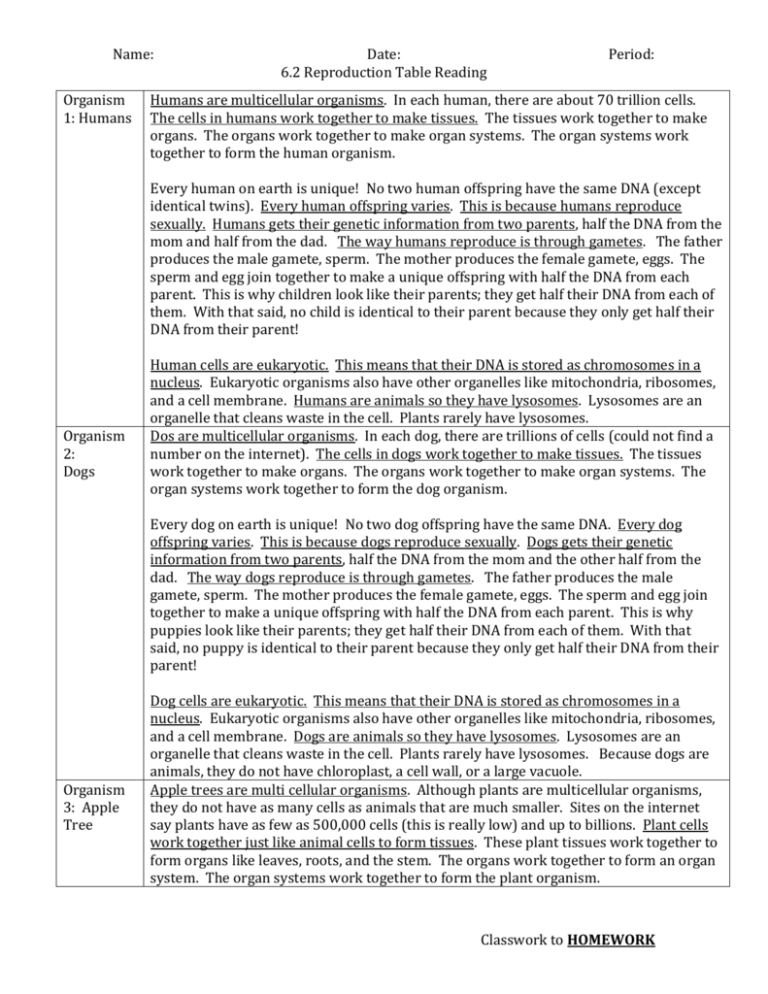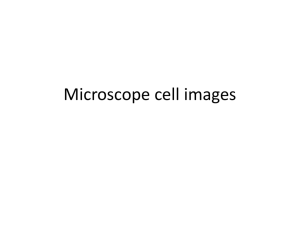6.2 Reproduction Table Reading
advertisement

Name: Organism 1: Humans Date: 6.2 Reproduction Table Reading Period: Humans are multicellular organisms. In each human, there are about 70 trillion cells. The cells in humans work together to make tissues. The tissues work together to make organs. The organs work together to make organ systems. The organ systems work together to form the human organism. Every human on earth is unique! No two human offspring have the same DNA (except identical twins). Every human offspring varies. This is because humans reproduce sexually. Humans gets their genetic information from two parents, half the DNA from the mom and half from the dad. The way humans reproduce is through gametes. The father produces the male gamete, sperm. The mother produces the female gamete, eggs. The sperm and egg join together to make a unique offspring with half the DNA from each parent. This is why children look like their parents; they get half their DNA from each of them. With that said, no child is identical to their parent because they only get half their DNA from their parent! Organism 2: Dogs Human cells are eukaryotic. This means that their DNA is stored as chromosomes in a nucleus. Eukaryotic organisms also have other organelles like mitochondria, ribosomes, and a cell membrane. Humans are animals so they have lysosomes. Lysosomes are an organelle that cleans waste in the cell. Plants rarely have lysosomes. Dos are multicellular organisms. In each dog, there are trillions of cells (could not find a number on the internet). The cells in dogs work together to make tissues. The tissues work together to make organs. The organs work together to make organ systems. The organ systems work together to form the dog organism. Every dog on earth is unique! No two dog offspring have the same DNA. Every dog offspring varies. This is because dogs reproduce sexually. Dogs gets their genetic information from two parents, half the DNA from the mom and the other half from the dad. The way dogs reproduce is through gametes. The father produces the male gamete, sperm. The mother produces the female gamete, eggs. The sperm and egg join together to make a unique offspring with half the DNA from each parent. This is why puppies look like their parents; they get half their DNA from each of them. With that said, no puppy is identical to their parent because they only get half their DNA from their parent! Organism 3: Apple Tree Dog cells are eukaryotic. This means that their DNA is stored as chromosomes in a nucleus. Eukaryotic organisms also have other organelles like mitochondria, ribosomes, and a cell membrane. Dogs are animals so they have lysosomes. Lysosomes are an organelle that cleans waste in the cell. Plants rarely have lysosomes. Because dogs are animals, they do not have chloroplast, a cell wall, or a large vacuole. Apple trees are multi cellular organisms. Although plants are multicellular organisms, they do not have as many cells as animals that are much smaller. Sites on the internet say plants have as few as 500,000 cells (this is really low) and up to billions. Plant cells work together just like animal cells to form tissues. These plant tissues work together to form organs like leaves, roots, and the stem. The organs work together to form an organ system. The organ systems work together to form the plant organism. Classwork to HOMEWORK Name: Date: 6.2 Reproduction Table Reading Period: Every apple tree on earth is unique because they reproduce sexually. That means every apple tree offspring varies from the parent tree. Apple trees reproduce using sex cells or gametes. The male gamete is pollen, and the female gamete is ovules. Even if an apple tree self pollinates, the pollen sperm and ovule egg have different halves of the trees DNA. No two pollen are the same and no two ovules are the same. The combination of the two from the same parent will lead to unique offspring with different combinations of DNA. It is really hard for apple trees to self pollinate because the pistil in the flowers work at different times than the stamen in the flower. This means that the genetic information in the offspring seed usually comes from two parents. With that said, apple trees can self pollinate as a last resort in an emergency. When this happens, the genetic information comes from the same parent, but the offspring is different from the parent. To reproduce, apple trees form gametes. The male gamete is the pollen and the female gamete is the ovule. Apple trees are eukaryotic, their cells have a nucleus with the DNA stored as chromosomes. Besides the nucleus, the cells in an apple tree have other organelles like the ribosome, mitochondria and the cell wall. The apple tree is also a plant so it has special organelles that are different from animal cells. These organelles include the chloroplast, large vacuole, and the cell wall. It is very rare for plants to have lysosomes. Apple trees do not have lysosomes. Strawberry Strawberry plants are multi-cellular organisms. Although plants are multicellular organisms, they do not have as many cells as animals that are much smaller. Sites on the internet say plants have as few as 500,000 cells (this is really low) and up to billions. Plant cells work together just like animal cells to form tissues. These plant tissues work together to form organs like leaves, roots, and the stem. The organs work together to form an organ system. The organ systems work together to form the plant organism. Although strawberries can reproduce sexually, for this activity we are going to focus on the asexual reproduction of the strawberry plant. In the table DO NOT MARK SEXUAL REPRODUCTION. The strawberry plant does produce fruit from its flowers, but I want you to learn and focus on the asexual reproduction of strawberries. Strawberries reproduce asexually. This means that the offspring strawberry plant is identical to the original strawberry plant. All the genetic information for the offspring plant came from the 1 parent plant. That’s right, 1 parent strawberry plant can lead to an identical clone offspring. This doesn’t require pollination or seeds. This means that a strawberry plant does not need to form the gametes pollen or ovules to reproduce. The strawberry plant can reproduce and make a brand new plant with no gametes at all! The way strawberries reproduce asexually is through special type of budding called vegetative reproduction. In vegetative reproduction, a part of the plant can form a completely new plant. By planting a fully grown leaf with a healthy stem, the leaf can take root and form a new strawberry plant. The other way strawberry plants asexually reproduce is through their roots. Their roots have things called runners. Runners are stems that grow from the roots of the strawberry plant. Classwork to HOMEWORK Name: Date: 6.2 Reproduction Table Reading Period: Strawberry plants are made up of eukaryotic cells. This means that in each cell of the plant is a nucleus with DNA stored as chromosomes. In addition, the plant cells are made up of organelles like the mitochondria, ribosome and cell membrane. Because strawberries are plants, their cells also have chloroplast, a large vacuole and a cell wall. Plant cells rarely have lysosomes. Strawberry plants do not have lysosomes. Organism 5 Tuberculosis Bacteria (TB bacteria) Bacteria are single cellular organisms. This means that one bacteria organism is made out of only 1 cell! That’s right, each tuberculosis bacteria cell or TB bacteria cell is its own organism. Because each cell is its own organism, TB bacteria does not form tissues. Tissues are made out of the same cells working together in an organism. The TB bacteria is a single celled organism and can not form a tissue working with itself. You may be wondering what a Tuberculosis Bacteria cell is. The word tuberculosis should be familiar. When you were a kid, you most likely took a Tuberculosis vaccine or a TB vaccine. This is a special shot preventing you from getting attacked by tuberculosis bacteria. TB bacteria usually gather in people longs, infecting their tissues. When this happens, they get very sick. In the past, before medicine was created, many people died from tuberculosis. When people have tuberculosis and they cough, they spread the bacteria. If you inhale or swallow the bacteria, it can go into your lungs. In your lungs the TB bacteria asexually reproduces to make many more TB bacteria. In asexual reproduction, the offspring are identical clones of the parent cell. One TB bacteria cell goes through binary fission. Binary fission is a process where one single cellular organism copies its DNA and splits into two identical single cellular organisms. This means all the genetic information (the DNA) in the two product cells comes from one parent cell. This process does not require the formation of gametes like in sexual reproduction. Bacteria cells are not just single celled. TB bacteria is also prokaryotuic. This means that DNA is not stored in a nucleus. The TB bacteria has 1 single chromosome in a loop floating in the cell. The TB bacteria also does not have any organelles except ribosomes. The TB bacteria has no chlropolast, Large Vacuole, or lysosome. Classwork to HOMEWORK Name: Organism 6: Yeast Date: 6.2 Reproduction Table Reading Period: Yeast can be found as single cellular organisms. This means that the yeast can not form tissues. Although yeast cells worktogether, a single cellular organism can not have tissues made out of cells working togeher. You may be wondering what yeast is. Most likely you’ve heard the word before. Yeast can do many things. The most common use of yeast is to make bread rise. Bread is made out of dough. The mitochondria in the yeast break down the sugar in the dough. This releases the gas carbon dioxide. When this happens the bread expands or rises. This makes bread light and fluffy. This is also why bread sometimes has holes in it. The carbon dioxide gas expanded separating the dough. While the mitochondria in yeast breaks down the sugar in bread, it gets the energy to function and reproduce. The yeast reproduces asexually. This means that a yeast cell make an offspring all on its own. There is only 1 parent that produces an identical offspring. All the genetic information in the offspring yeast cell comes from one parent cell. This makes the offspring an identical clone to the parent. To reproduce, the yeast does not form gametes. The yeast does a special asexual reproduction process call budding. Yeast cells live and work together in colonies (just like humans live and work together). As the yeast cells grow in the colony, one of the cells DNA is copied and a new cell “buds off” or grows off the orginal cell. Yeast are single cellular organisms. Although yeast and bacteria are both single cellular, they are very different from each other. The yeast is eukaryotic while the bacteria is prokaryotic. This means that the yeast has a nucleus with DNA stored in the nucleus as chromosomes. The yeast also have different organelles. Yeast are very unique. They are not plants, but they are also not animals. They are in their own kingdom, the fungai kingdom (fungai is plural for fungas). Another very common fungus is mushrooms! The yeast does not have lysosomes. Instead, the yeast have a large vacuole that does the same job, cleans the cell. The yeast do not have chloroplast like plants and do not make their own food. The yeast do have a cell wall, but it is very different from a plant cell wall. The yeast cell wall is made from a different sugar. Classwork to HOMEWORK









